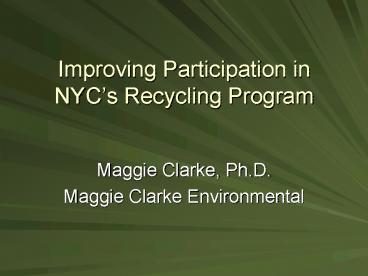Improving Participation in NYCs Recycling Program - PowerPoint PPT Presentation
1 / 27
Title: Improving Participation in NYCs Recycling Program
1
Improving Participation in NYCs Recycling Program
- Maggie Clarke, Ph.D.
- Maggie Clarke Environmental
2
NYC Recycling Timeline
3
New Yorks Waste Management
- No In-City Disposal Last Landfill
closed 2001 - Mandatory Recycling Law 1989
- Required 25 Diversion by 1994 (Failed)
- Export of Uncaptured Recyclables, Organics,
- and other Discards to nearby WTE and far away
Landfills
4
History of Education and Enforcement
- Education intermittent transient population
large - Mailers less than once per year average
- TV, radio spots every few years
- School package, good but not given to all
- Specialized reports available on website
- Posters, stickers use pictograms / several
languages available (but are they used
appropriately?) - 3 Rs composting get only 5 of over 1 Billion
Sanitation budget for 8.5 million people (most
pays for processing) - New Office of Recycling Outreach Education in
Mayors Office (2007) good start one staffer
per borough (5)
5
History of Enforcement
- Enforcement has been uneven
- Early Deal with Landlords not to enforce even
though Law can fine landlords up to 10,000.
(Doesnt happen) Only ticketed for no signage. - Some homeowners get a ticket for one wrong item
- New York University gets ticket every week
guaranteed to have one wrong item - Capture rate less than 50 so almost guaranteed
to find recyclables in trash - Only recyclables are in clear bags garbage is in
black bags so its hard to tell if recyclables
are being trashed.
6
NYC Diversion Rates by District
From DOS New York City Recycling In Context
A Comprehensive Analysis of Recycling in Major
U.S. Cities. August, 2001. This was prior to the
July, 2002 citywide reduction in recycling
service after which time only papers and metals
were collected until July, 2003.
7
Geographic Distribution of Best and Worst
Recycling Districts
8
Positive Correlations Between Poor Recycling
Participation and Demographics
Correlation r .83 to .88 for each of these,
where 1.0 is perfect correlation
9
NYC district diversion rate and per capita
generation
10
But What Is It About the Demographics That
Results in Poor Recycling Participation?
- We Need to Study the Contributory Factors to
Recycling Behavior
11
Achieving Participation
12
Results of Dissertation Research
- Path Analysis Model Knowledge Attitudes
Behavior? - Contributions to (Recycling) Behavior
- Small amount by Knowledge
- Some by Attitude
- Lots from other Factors Outside the Model
- Beliefs, social norms, ability, experiences with
recycling
13
Why Such a Disparity?
- Possible Reasons
- Differences in Understanding of Recycling
Program Instructions - Differences in Motivation / Poor Attitude
- Differences in Convenience Factors / Barriers
- All Can be Assessed by Administering
Questionnaires to Residents of Good and Poor
Recycling Districts
14
NYC Recycling Disparity Research Design
- 2-page surveys administered
- Knowledge, Attitude, Barriers, Demographics
Questions - 3 Administrations 2003 to 2005
- During and After Major Recycling Program Changes
(Cuts then Restorations) - Student administered (Removed suspicious results)
- Eventually over 2,000 surveys
15
Knowledge Factors - overall
16
Confusion by Residents
17
Knowledge factors by diversion rate
18
Knowledge disparities amongst districts
19
Knowledge disparities amongst districts
20
Possible Reasons For Not Participating(overall
results)
21
Disparities Affecting Diversion
22
More Associations with Diversion Rate
23
Main single reason for not recycling all
recyclable items every time
24
Findings
- Diversion rate correlates not only with
- demographics (income, education, race)
- but also
- Recycling Area Location Conditions
- Knowledge of Recycling Program Elements
- Local Area / Street Cleanliness
25
Conclusions / Recommendations
- Improve Recycling Education
- Frequency of Education (I Forget to Recycle)
- What to Recycle (Im Confused)
- Why Recycle (I dont think I should have to)
- Target Especially to those who need it most (Low
Income, Education, and Diversion areas) - Stabilize Recycling Program to Optimize Good
Attitude - Dont Reduce Number of Recyclables Targeted Only
Increase - Keep Weekly Pickup of Recyclables
26
Recommendations
- Increase and Improve Enforcement
- Continuing Equitable Enforcement, Targeted more
to Apartment Building Recycling than in the past - Collect Garbage in Clear Bags (perhaps
translucent gray to differentiate from clear and
translucent green bags) - Implement Equitable Street Collections and
Cleanings Amongst Neighborhoods - Remove Barriers, e.g. Enact Building Codes to
Encourage Same-Floor Recycling Areas
27
- Maggie Clarke, Ph.D.
- l
- Maggie Clarke Environmental
- 1795 Riverside Drive, 5F
- New York, NY 10034
- 212-567-8272
- www.maggieclarkeenvironmental.com
- mclarke_at_hunter.cuny.edu






























